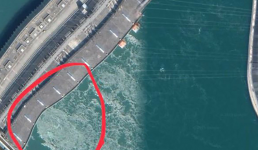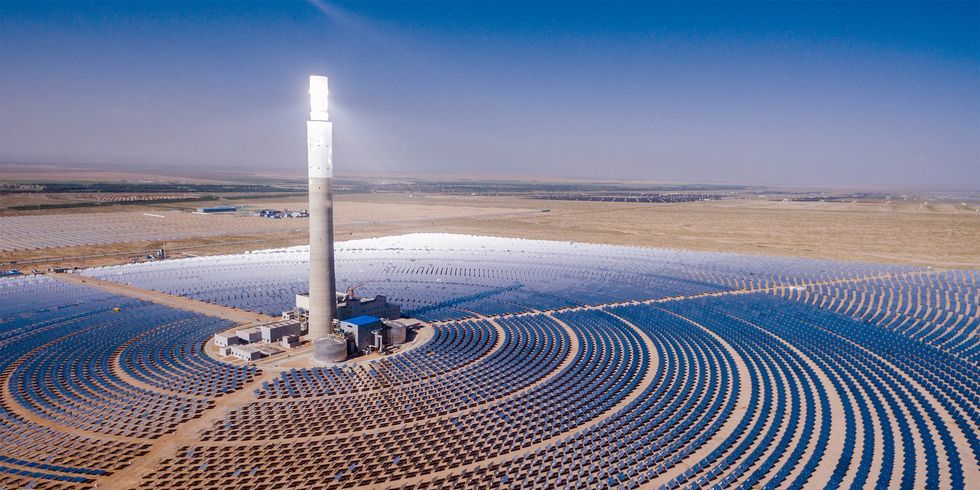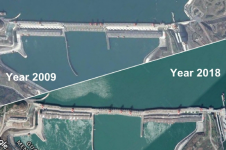3 Gorges dam is failing. A big ol mess isnt far off.Three Gorges Dam has the solar industry beat by itself. Heard it from the top that "water can be counted on". Also greener than the solar panel business.
The big China disaster that you're missing
-
 This aerial photo taken on Aug. 23 shows water being released from China's Three Gorges Dam in Yichang, Hubei province. | AFP-JIJI
This aerial photo taken on Aug. 23 shows water being released from China's Three Gorges Dam in Yichang, Hubei province. | AFP-JIJI
BY ANJANI TRIVEDI
- BLOOMBER Sep 1, 2020
The problem isn’t that China lacks water management projects. It has built hundreds of thousands of levees, dikes, reservoirs and dams on its seven major river systems. But many are struggling to cope with months of rain-fed flooding that has ravaged vast swathes of industrial and agricultural land and engulfed millions of homes. This past week, officials feared that the Three Gorges Dam on the mighty Yangtze was peaking and could overflow. Elsewhere, authorities have blown up barriers that were causing more damage than help.
China has experienced three of the world’s 10 most devastating floods since 1950. The limited number of deaths this time is a testament to how far the country has come, with officials saying that at least 219 people have died or disappeared. Yet flooding in cities is getting worse, a sign of rising populations and failure to execute urbanization policies.
Annual average losses from river inundations are the highest in the world. Flood policy hasn’t been made the a priority it should be given the high stakes. The Yangtze River Economic Belt is home to more than 40 percent of China’s population (about 600 million people) and accounts for almost 50 percent of export value and 45 percent of gross domestic product, according to China Water Risk. On its own, the region could be the third-largest economy in the world.
More severe disasters are anticipated. Hydroclimatologist Peter Gleick, a member of the U.S. National Academy of Sciences, told the South China Morning Post that climate change is increasing the risks of extreme rainfall events, making it “even more likely that dams like the Three Gorges will be unable to prevent the worst flooding from occurring in the future.”
A study has found that if temperatures rise by 2 degrees, flows around the Yangtze and other major world rivers will intensify, increasing the frequency of huge floods. Heavy rain days are already more numerous and intense inside cities compared to suburban areas along the Yangtze, a study using rainfall records over two periods between 1961 and 2010 found. Such days increase by 30 percent on average in places like Suzhou, near Shanghai, known for wedding gowns and bridal exports along with big tech factories.
China isn’t shy about deploying money. Last year, 726 billion yuan ($105 billion) was shoveled into water conservancy construction — the highest in history, according to CLSA Securities Ltd. Flood management has received 1.2 billion yuan in central government funds since the beginning of the rainy season. But there’s competition. Trillions of yuan are being spent to support a national recovery from COVID-19, including building massive 5G capacity to ensure future manufacturing capabilities.
That’s certainly justifiable. Roads to nowhere aren’t. Past disasters tend to frame thinking about future ones. Yet threats aren’t static — climate change is speeding up the severity of flooding. Risk assessments need to factor in where China’s wealth is being built. For instance, quantifiable flood losses in heavily industrialized Guangdong province in 2015 reached around 30 billion yuan, but disruption to its concentration of roads and railways, ports and airports pushed costs far higher. The cities of southern China are at great jeopardy.
One example of how mitigation efforts are being outpaced is the strategy of diversion zones adopted two decades ago, setting aside areas where authorities released water to control excessive flow. Resettled people have since been driven further away from zones where they were supposed to live as ever-larger amounts of water need to be unleashed. Eventually, they end up on lands that aren’t eligible for compensation.
Beijing’s ministries have issued streams of climate change-related rules and targets, and China was at one point considered a leader. This was supposed to be the year that companies got better about environmental and social governance disclosures. Constrained coffers, the viral outbreak, trade war with the U.S., and slowing economic growth will make it harder to put future floods and the like front of mind. That needs a rethink.
Consider this knock-on effect. In theory, banks will likely take losses because of natural disasters; their clients will pass them along to insurers. In China, insurance companies aren’t well-prepared; statistics remain sparse and risk-modelling around flood events has become more difficult. In 2016, China’s nonlife insurers were hit with losses of more than 4 billion yuan related to floods and storms between June and August. This time, Fitch Ratings Inc. analysts expect claims “to continue to surge as the rainy season is not over yet in certain parts of China.” They noted on July 15 that insurers in Hubei, Guangxi and Jiangxi provinces had reported aggregate incurred losses of more than 500 million yuan as of a week earlier, including claims from motor, agricultural and property insurance.The last thing China’s burdened, state-run financial institutions need are continued natural disasters. As tough as this year has been, it may be time to re-calibrate priorities. Building 5G base stations and rail lines won’t matter if they get wiped out by floods again and again.


